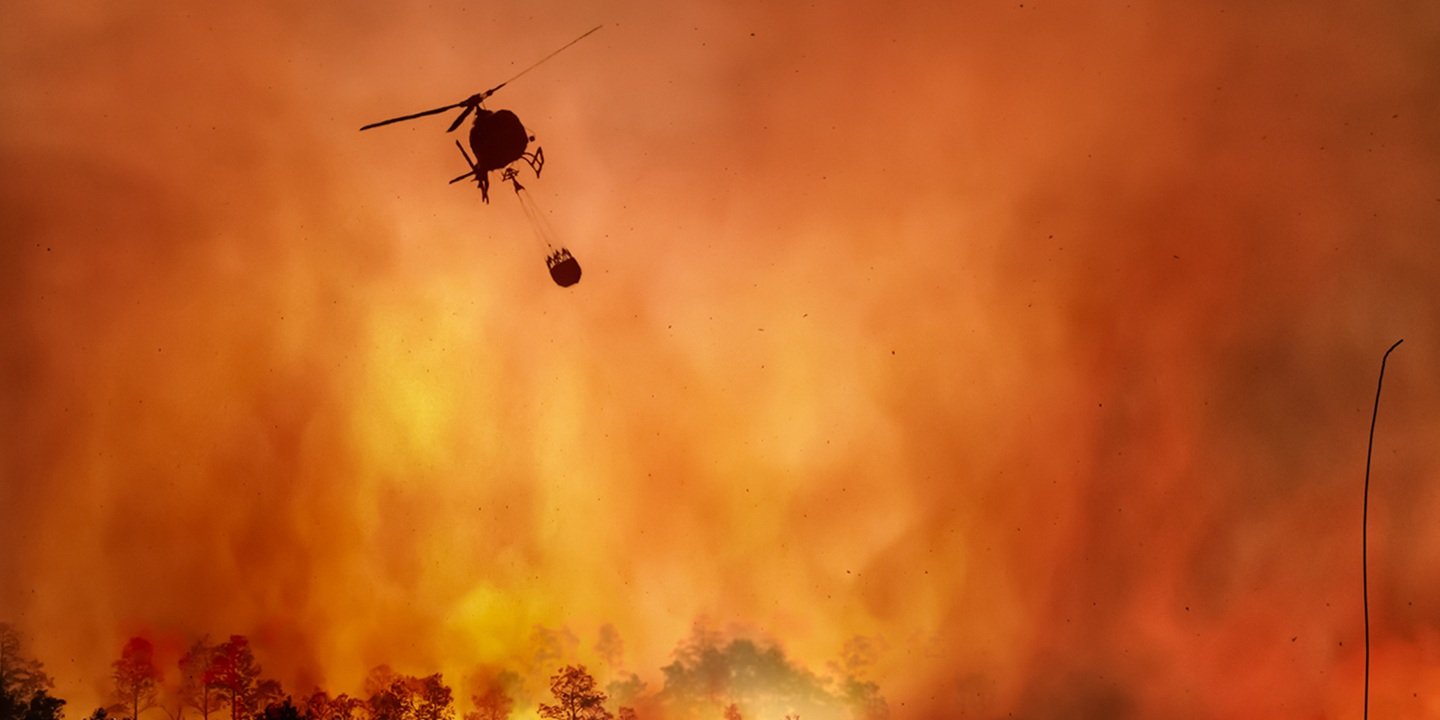Wildfire loss mitigation starts with a plan
Climate and EnergyArticleJuly 17, 2025
Wildfires are destructive, deadly and unpredictable. Because of climate change, they are occurring more frequently and burning for much longer than they used to. Wildfire “season” has become a nebulous term, as these destructive firestorms now happen throughout the year and throughout the country, from California to the Northwest, and in Texas, Colorado, Florida and throughout the forested areas of the Midwest.
Despite the growing risk, business owners in areas prone to wildfires can take some steps to help mitigate their risk and protect their employees.
Any mitigation efforts should start with a clear and well-practiced plan. Business owners should work closely with local fire officials and implement physical improvements to prevent wildfires from reaching or igniting your properties.
Start by developing a wildfire emergency plan
Protecting your property and your people begins with developing an emergency plan that addresses actions to take before, during and after a wildfire. The plan should include the following:
- Organize an internal work team to collaborate with local and wildland firefighters.
- Conduct a business impact analysis to assess business resiliency.
- Review shutdown and evacuation processes, including data backup, as well as shipping important tools, dies and records offsite.
- Create a business continuity plan.
- Monitor for wildfires year-round.
Business owners will need to rely on firefighters to help protect their properties, so it is important that they make it as easy as possible for them to do their job. Here’s how business owners can help:
- Create a pre-incident checklist that includes information about your facility, such as building layout, description of occupancies, and alarm and fire-protection systems.
- Maintain site entrances and ensure they’re clearly marked.
- Provide and clearly identify water sources, including fire hydrants, swimming pools, water storage tanks, wells and ponds.
- Make sure entrances to your facility are large enough to accommodate emergency vehicles.
Effective pre-wildfire planning includes interaction with local authorities as well as employees to develop and fine-tune pre-wildfire strategies. Business owners should schedule regular inspections by the fire department to ensure they are up to date on their pre-incident checklist and any changes in their facility. They should also develop an evacuation plan and regularly schedule fire drills to assess time, staff and resource needs.
Stop the wildfire spread
Wildfires spread by following a continuous path of combustibles. Windborne embers also present a threat, so the key to preventing a wildfire from reaching or igniting your property is removing combustibles on and around the property. Here are some things to consider:
- Have sufficient open space free of vegetation and other combustibles between your business and any nearby forest.
- Provide open space of at least 25 feet between property and long grass or desert scrub, and at least 200 feet between property and forested areas.
- Invest in exterior building surfaces that are either noncombustible or considered resistant to ignition by embers.
- Consider outside sprinklers to protect the building.
- Limit yard storage and remove flammable items, vehicles and, especially, propane tanks from the property or move them at least 100 feet away from the building.
- Close and seal building openings with tight-fitting, non-combustible materials.
- Shut building air intakes.
- Install tight-fitting, noncombustible doors, shutters and/or dampers that can be closed when implementing your wildfire plan.
- Fully close and seal windows and doors, including garage doors.
- Cut the grass (keep below six inches) and irrigate the landscaping.
- Limit landscaping materials to noncombustible materials like stone, rock, brick and concrete pavers. Avoid combustible materials like mulch, wood ties and plastic ornamentations.
Where there’s smoke, there’s soot
Wildfires can produce plumes of smoke that spread far in advance of the fire itself, causing damage to a building even if flames never reach it. Smoke and soot damage from wildfires has resulted in multi-million dollar losses, often by being sucked into a building when HVAC systems are operating or reactivated after a fire. Here are some ways to minimize the impact:
- Find ways to keep soot and smoke from entering the building. For example, install louvers that automatically close when they’re not being used.
- Have a plan in place to shut down HVAC systems when necessary.
- Provide non-combustible covers for HVAC openings that can withstand high winds and contact with small items.
- Provide a way to automatically stop air intake fans upon smoke detection.
- Provide duct-type smoke detectors in all outside air intakes.
- Interlock duct-type smoke detectors to automatically remove power from air intake fans and automatically close air intake dampers upon smoke detection.
- Examine all HVAC systems, clean surface areas and replace filters before resuming operation after a fire.
Following these steps can help businesses mitigate property losses well before they are facing an imminent threat from a wildfire. Business owners will also need to consider what actions to take as a wildfire approaches and how they can recover from losses caused by a wildfire.
These actions should be part of a fully developed wildfire Emergency Response Plan (ERP). The articles in the Wildfire Resource Hub detail the risks of wildfires and the other major components of a wildfire ERP. Taken together, they can provide your business with a path to reduced risks and faster recovery.
